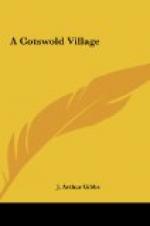This Great Western Railway runs through some of the finest bits of old England. Not long ago, in travelling from Chepstow to Gloucester, we were fairly amazed at the surpassing beauty of the views. It was May-day, and the weather was in keeping with the occasion. The sight of the old town of Chepstow and the silvery Wye, as we left them behind us, was fine enough; but who can describe the magnificent panorama presented by the wide Severn at low tide? Yellow sands, glittering like gold in the dazzling sunshine, stretched away for miles; beyond these a vista of green meadows, with the distant Cotswold Hills rising out of dreamy haze; waters of chrysolite, with fields of malachite beyond; the azure sky overhead flecked with clouds of pearl and opal, and all around the pear orchards in full bloom.
While on the subject of scenery, may I enter a protest against the change the Great Western Railway has lately made in the photographs which adorn their carriages? They used to be as beautiful as one could wish; lately, however, the colouring has been lavished on them with no sparing hand. These “photo-chromes” are unnatural and impossible, whereas the old permanent photographs were very beautiful.
At Kemble, with its old manor house and stone-roofed cottages, we say good-bye to the Vale of White Horse; for we have entered the Cotswolds. Stretching from Broadway to Bath, and from Birdlip to Burford, and containing about three hundred square miles, is a vast tract of hill country, intersected by numerous narrow valleys. Probably at one period this district was a rough, uncultivated moor. It is now cultivated for the most part, and grows excellent barley. The highest point of this extensive range is eleven hundred and thirty-four feet, but the average altitude would not exceed half that height. Almost every valley has its little brook. The district is essentially a “stone country;” for all the houses and most of their roofs are built of the local limestone, which lies everywhere on these hills within a few inches of the surface. There is no difficulty in obtaining plenty of stone hereabouts. The chief characteristics of the buildings are their antiquity and Gothic quaintness. The air is sharp and bracing, and the climate, as is inevitable on the shallow, porous soil of the oolite hills, wonderfully dry and invigorating. “Lands of gold have been found, and lands of spices and precious merchandise; but this is the land of health” Thus wrote Richard Jefferies of the downs, and thus say we of the Cotswolds.




